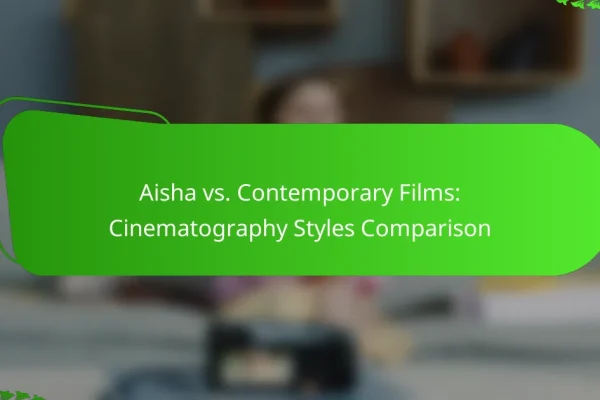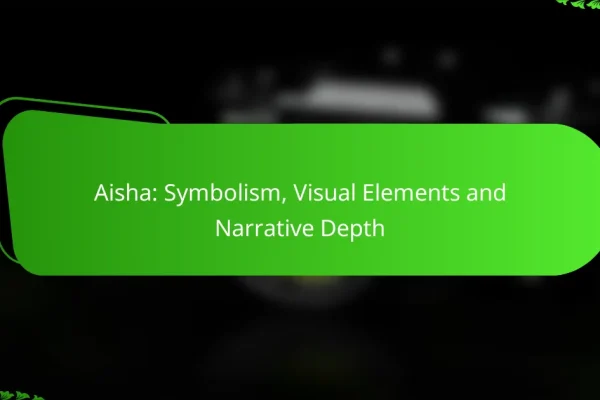What cinematography techniques are used in Aisha?
Aisha employs a variety of cinematography techniques that enhance storytelling and emotional depth. Key methods include natural lighting, dynamic camera movements, close-up shots, color grading, and thoughtful framing, all contributing to the film’s visual narrative.
Use of natural lighting
The use of natural lighting in Aisha creates a realistic and relatable atmosphere. By utilizing sunlight and ambient light sources, the film captures authentic moments that resonate with viewers. This technique often involves shooting during golden hours to achieve warm tones and soft shadows.
Filmmakers should consider the time of day and weather conditions when planning scenes. Natural light can vary significantly, so flexibility in shooting schedules is essential to maintain consistency in visual quality.
Dynamic camera movements
Aisha features dynamic camera movements that enhance the storytelling experience. Techniques such as tracking shots and handheld cinematography create a sense of immediacy and engagement, allowing viewers to feel part of the action. These movements can convey urgency or intimacy, depending on the scene’s context.
When implementing dynamic movements, it’s crucial to maintain stability and focus. Using stabilizers or gimbals can help achieve smooth transitions, while careful choreography ensures that the camera complements the actors’ performances.
Close-up shots for emotional impact
Close-up shots are strategically used in Aisha to convey characters’ emotions and reactions. By focusing on facial expressions, the audience gains insight into the characters’ inner thoughts and feelings, enhancing emotional engagement with the story.
Filmmakers should balance the use of close-ups with wider shots to avoid overwhelming viewers. A well-timed close-up can amplify a pivotal moment, making it more memorable and impactful.
Color grading for mood enhancement
Color grading in Aisha plays a vital role in establishing mood and tone. By adjusting hues, saturation, and contrast, the film creates visual cues that align with the narrative’s emotional landscape. Warm tones may evoke feelings of comfort, while cooler shades can suggest tension or sadness.
When color grading, it’s important to maintain consistency throughout the film. A cohesive color palette helps unify scenes and reinforces the overall theme, guiding the audience’s emotional response.
Framing and composition strategies
Framing and composition in Aisha are carefully crafted to direct viewers’ attention and enhance storytelling. Techniques such as the rule of thirds and leading lines help create visually appealing shots that draw the eye to key elements within the frame.
Filmmakers should experiment with different angles and perspectives to find the most effective compositions. Thoughtful framing not only enhances visual interest but also reinforces the narrative by emphasizing relationships between characters and their environment.
How does Aisha utilize lighting techniques?
Aisha employs a variety of lighting techniques to enhance the film’s visual storytelling. The use of both natural and artificial lighting creates distinct atmospheres that support the narrative and character development.
Natural light for authenticity
Natural light is a key element in Aisha, providing a sense of realism and authenticity to the scenes. By shooting during the golden hour, filmmakers capture softer, warmer tones that enhance the emotional depth of the story.
Utilizing natural light also allows for dynamic changes throughout the day, which can reflect the characters’ moods or the progression of time. This technique often requires careful planning to ensure that scenes are shot at optimal times to achieve the desired effect.
Artificial lighting for dramatic effect
Artificial lighting in Aisha is strategically used to create dramatic contrasts and highlight key moments. Techniques such as backlighting and spotlighting draw attention to specific characters or actions, enhancing the narrative tension.
Using gels and filters can modify the color temperature of artificial lights, allowing filmmakers to evoke different emotions or set a particular tone. It’s essential to balance artificial light with existing natural light to maintain visual coherence and avoid harsh shadows.
What camera movements are prominent in Aisha?
Aisha employs various camera movements that enhance the visual storytelling experience. Key movements include tracking shots and panning techniques, which contribute to the film’s dynamic narrative flow and emotional depth.
Tracking shots for immersive storytelling
Tracking shots in Aisha are used to follow characters as they navigate their environments, creating a sense of intimacy and engagement. This technique allows viewers to feel as though they are part of the action, enhancing emotional connections with the characters.
When implementing tracking shots, consider the pace of the movement. A slower tracking shot can build tension, while a faster one may convey urgency. For example, following a character through a bustling market can immerse the audience in the vibrant atmosphere.
Panning techniques for scene transitions
Panning techniques in Aisha serve as effective tools for transitioning between scenes or highlighting important elements within a frame. A smooth pan can guide the viewer’s attention from one subject to another, maintaining narrative continuity.
To execute a successful pan, ensure the movement is steady and controlled. Quick pans can disorient viewers, while slow pans allow for a more deliberate reveal of details. For instance, panning across a scenic landscape can establish the setting before introducing the characters.
How does the color palette influence Aisha’s cinematography?
The color palette in Aisha’s cinematography plays a crucial role in shaping the film’s emotional landscape and visual storytelling. By strategically using colors, the filmmakers create distinct moods and highlight character dynamics throughout the narrative.
Warm tones for intimacy
Warm tones, such as reds, oranges, and yellows, are employed in Aisha to evoke feelings of closeness and affection. These colors often appear in scenes that focus on personal relationships, enhancing the emotional connection between characters.
For example, during intimate conversations or romantic moments, the use of warm lighting can soften the atmosphere, making viewers feel more engaged with the characters’ experiences. This technique is effective in drawing the audience into the emotional core of the story.
Cool tones for tension
In contrast, cool tones like blues and greens are utilized to create a sense of unease and tension in Aisha. These colors often dominate scenes that involve conflict or uncertainty, signaling to the audience that something is amiss.
For instance, when characters face challenges or confrontations, the cooler palette can heighten the drama, making the stakes feel more significant. This visual choice effectively communicates the underlying tension without the need for dialogue, allowing viewers to intuitively grasp the emotional weight of the situation.
What role does composition play in Aisha?
Composition is essential in Aisha, as it shapes how viewers perceive the story and characters. Effective composition enhances visual storytelling by guiding attention and creating emotional resonance.
Rule of thirds for balance
The rule of thirds is a fundamental principle in cinematography that divides the frame into a 3×3 grid. Placing key elements along these lines or at their intersections creates a balanced and engaging composition. In Aisha, this technique can highlight character interactions or significant objects, making scenes more dynamic.
To apply the rule of thirds, visualize the grid and position focal points accordingly. For example, when framing a character, place them on one of the vertical lines rather than in the center. This approach can lead to more visually appealing shots that draw the viewer’s eye naturally.
Leading lines to guide viewer focus
Leading lines are compositional elements that direct the viewer’s gaze towards the main subject. In Aisha, these lines can be natural features like roads, fences, or architectural elements that frame the action. Utilizing leading lines helps create depth and perspective, enhancing the storytelling experience.
To effectively use leading lines, identify elements in the scene that can guide the viewer’s focus. For instance, a pathway leading to a character can create a sense of journey or anticipation. Be mindful of how these lines interact with other compositional techniques to maintain visual coherence.
What are the prerequisites for understanding Aisha’s cinematography?
To grasp Aisha’s cinematography, familiarity with basic film concepts such as framing, lighting, and camera movement is essential. Understanding these elements will help viewers appreciate the visual storytelling techniques employed in the film.
Framing Techniques
Framing in Aisha is crucial for conveying emotions and character relationships. The use of close-ups allows the audience to connect with the characters’ feelings, while wide shots establish context and setting. Directors often utilize the rule of thirds to create visually appealing compositions.
Consider how Aisha employs framing to enhance storytelling. For instance, scenes featuring intimate conversations often use tighter frames, while broader scenes may showcase the bustling environment around the characters. This contrast helps to emphasize the narrative’s emotional highs and lows.
Lighting Choices
Lighting plays a significant role in Aisha’s cinematography, influencing mood and atmosphere. The film utilizes natural light in outdoor scenes, creating a warm and inviting feel, while indoor scenes often feature softer, diffused lighting to evoke intimacy.
When analyzing lighting, pay attention to how shadows and highlights shape the characters’ appearances. High-key lighting can suggest happiness, while low-key lighting may indicate tension or conflict. Understanding these choices can deepen your appreciation of the film’s visual language.
Camera Movement
Camera movement in Aisha enhances the storytelling by guiding the viewer’s attention and creating a sense of dynamism. Techniques such as tracking shots and pans are employed to follow characters or reveal important details within a scene.
For example, a smooth tracking shot might follow Aisha as she navigates a crowded market, immersing the audience in her world. Conversely, static shots can create tension by forcing viewers to focus on the characters’ interactions. Recognizing these movements helps to appreciate the film’s pacing and emotional impact.












